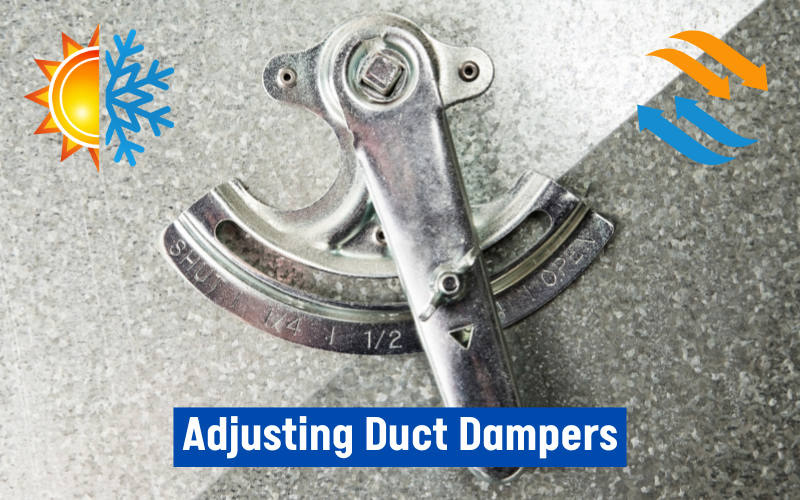For many homeowners, the quirks of their HVAC system can be both puzzling and frustrating. Imagine this scenario: it’s winter, and while your living room is delightfully cozy, your nose feels numb as soon as you step out of bed in the morning.
In contrast, in July, your kids are overwhelmed by the heat in their rooms, yet elsewhere in the house, it’s so cool you need a hoodie. Hahaha. The inconvenience behind this is the unadjusted dampers. An HVAC system is designed to distribute hot air and cold air throughout your home or commercial facility.
Thankfully, there is a solution that doesn’t require professional help: adjusting your HVAC dampers.
Yet, many users don’t realize they can control this airflow manually, deciding exactly how much air enters each space and whether the issue is too much warmth upstairs in the summer. Or a stifling atmosphere when the heater switches modes, tweaking the settings of your air duct dampers can offer immediate relief.
I assure you that with a few simple tips, you can learn to switch dampers between seasons and understand whether they are open or closed, restoring the balance of your home environment.
What is an HVAC Damper?

An HVAC damper is a device used to regulate the airflow within your HVAC system. Unlike registers on the floor or ceiling, dampers are near the HVAC unit. They control the airflow more using an external lever that moves a metal plate inside the duct. When you adjust this lever, you can rotate the plate to direct heated or cooled air to different parts of your home. This method ensures each room gets the right amount of processed air.
Spotting Location of HVAC Dampers
Once you find a damper, you can optimize your system. Typically, they are located a few feet from the furnace on the main ducts. If your home has an older or manually controlled system, you must manually identify and adjust these dampers. Start by inspecting the ductwork near the furnace. Look for the lever that controls the plate inside the duct.
In more premium setups, dampers are automatically controlled, offering luxury and comfort without manual adjustment. However, even in homes without such features, adjusting dampers can lead to a noticeable improvement in indoor climate control.
House builders and contractors often skip installing these in new homes to save costs, but adding them can be very beneficial. If your system hasn’t been reconfigured to include dampers, it’s worth considering.
How to Adjust Dampers in Ducts? – 8 Steps to Go!
Let’s adjust your air duct dampers:
Step 1: Prepare Your System
Turn your fan to the ON position and, if necessary, adjust your thermostat so the system runs constantly during the adjustment process. This will confirm whether the air is moving completely uninhibited through the duct network.
Step 2: Open All Dampers & Registers
Open every damper by turning the lever so it’s pointed in the same direction as the duct. Similarly, confirm that each register of a room of your house is wide open to allow for complete airflow.
Step 3: Identify Duct Connections
From your central unit, follow each duct as far as you can before it disappears. This helps to determine which duct serves which rooms. Once you identify them, close one damper at a time to verify which rooms are affected.
Step 4: Label Dampers
When adjusting your duct dampers, it’s essential to understand the different types of air ducts for air conditioners. After confirming where each duct leads, label it to save time in future adjustments.
Step 5: Make Initial Adjustments
Adjust the damper lever to control the airflow. For cold weather, you’ll want to maximize heat by reducing airflow upstairs and increasing it downstairs since hot air rises. In summer, do the opposite. Adjust for warm or cool air in a one-story home’s most frequently used rooms.
Step 6: Monitor and Adjust
After making your initial adjustments, set the system back to auto and monitor the comfort level in each room over a couple of days. Adjust again as necessary to fine-tune each room’s temperature. Repeat this process until the airflow feels comfy.
Step 7: Finalize Settings
Once you are happy with the airflow, mark the position of each damper directly on the duct. This labeling helps you remember the optimal settings for both winter and summer, reducing the need for a trial-and-error process each season.
Step 8: Adjust for Season Change
Whenever you switch from heat to air conditioning, add a reminder in your phone to adjust your dampers again. Avoid just setting the dampers to the opposite of where they were and assuming it’s good.
Adjusting Airflow in Homes Without Installed Dampers
If your home does not have dampers installed in the air duct systems, you can still adjust the airflow to suit your needs. Typically, systems are designed with a Manual J and D load and evenly distribute air without manual adjustments. Since the calculation considers all aspects of the home, including windows, doors, roof, and insulation, not everyone’s comfort preferences are the same—some might like it hotter, others colder.
For those needing to make adjustments manually, one approach is to close or partially shut the register in areas like the bathroom or other less frequented rooms to reduce airflow. This method isn’t as precise as having dampers, but it can eliminate excess flow and better balance temperatures across different rooms.
4 Tips After Adjusting HVAC Dampers
Are you done with the adjustments of the dampers? Now consider these tips before you pack up your toolbox!
1. Monitor Ambient Air Temperatures
After making the necessary airflow adjustments, monitor the ambient air temperature in each room for vigilance. You get a sweet spot for your preferences. You may need to repeat the process if you find a room too warm or too cool.
2. Adjust for Seasonal Changes
As the seasons change, so do your indoor heating and cooling needs. When the weather turns from cold to hot air, it’s often necessary to adjust the airflow. So, reconfigure the vents that were set up for winter use.
3. Make Small Adjustments
Don’t go with big jumps. Instead, start with small adjustments. A minor tweak in one room can significantly impact elsewhere in the house. That’s why professionals recommend beginning with incremental changes. Avoid completely closing or opening a damper. If a room is too hot, slightly crank open the damper to increase airflow; conversely, if a room is too cool during summer, close the vent to reduce the air entering the space.
4. Maintaining Your Ducts
Keeping your ducts in good condition is as important as adjusting the airflow. Many uneven heating or cooling issues stem from dirty ducts that choke off the airflow. Thus, HVAC cleaning removes the dirt and debris accumulated throughout the year. It improves the quality of life within your home.
FAQs
How can you tell if an HVAC damper is open or closed?
To check if a damper is open or closed, look for the wing nut on the bolt; its flat spot indicates the damper’s position. If the wing nut is horizontal, the damper is open. An angle means it’s closed, reducing the airflow through the duct.
When should you adjust your HVAC dampers?
Adjust your dampers at the start of changing seasons, mainly when switching from cool to warm settings, like turning on the furnace. This helps redirect air to areas like the upstairs that may get too hot or cold.
What if adjusting the dampers doesn’t solve airflow issues?
If hot spots or cold spots persist after adjusting dampers, check for blocked air vents or dirty air filters that might block airflow. Air leaks in the ductwork can also cause imbalances, so consider duct sealing to improve air balancing in your home.




 …
…
Leave a Reply